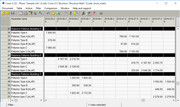Good Afternoon,
I have re-visited some cost loading bars in the programme and split them out in order for the commerical team to accurately represent the cost spread.
The actual start date for the cost bars is in the past, i.e. before the data date and have been actualised. Whilst reviewing the spread of the budgeted cost, it was clear the monies were not being spread across the correct months. To try and rectify this, I deleted the resource and assigned a completely new resourse budget and put it on a linear curve. This did not work.
I was then informed that it is most likely because the planned start / planned finish dates did not match the actual dates.
I installed the planned start / planned finish columns and adjusted these dates to match the actuals. This now worked.
My questions are as follows:
1) Why do the planned start / planned finish dates drive the spread of the monies and not the actual start / finish dates?
2) The start / finish dates are going to most likely move every period, therefore, do I need to continually update the planned start / planned finish dates to match the new actuals to give an accurate spread of money?
3) Where else would I need to consider planned start / planned finish dates in my planning duties?
Thanks
Kieran







Replies